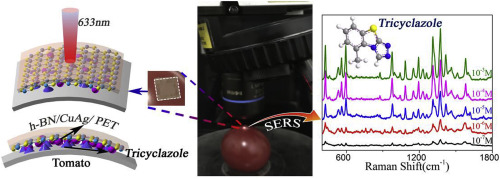当前位置:
X-MOL 学术
›
J. Alloys Compd.
›
论文详情
Our official English website, www.x-mol.net, welcomes your
feedback! (Note: you will need to create a separate account there.)
Blue laser-induced photochemical synthesis of CuAg nanoalloys on h-BN supports with enhanced SERS activity for trace-detection of residual pesticides on tomatoes
Journal of Alloys and Compounds ( IF 5.8 ) Pub Date : 2020-06-01 , DOI: 10.1016/j.jallcom.2020.153996 Hua Zhang , Qingqiang Cui , Linlin Xu , Anxin Jiao , Yue Tian , Xiangdong Liu , Shuang Li , Hengshuai Li , Ming Chen , Feng Chen
Journal of Alloys and Compounds ( IF 5.8 ) Pub Date : 2020-06-01 , DOI: 10.1016/j.jallcom.2020.153996 Hua Zhang , Qingqiang Cui , Linlin Xu , Anxin Jiao , Yue Tian , Xiangdong Liu , Shuang Li , Hengshuai Li , Ming Chen , Feng Chen

|
Abstract The copper (Cu)-based nanoalloys loaded on graphene-like nanoplates have a great promise for boosting surface-enhanced Raman scattering spectroscopy (SERS), due to low-cost Cu species in comparison with noble metals and unique additional Raman enhancement originated from two-dimensional (2D) supports. Herein, we report an ingenious strategy to load highly dense and monodisperse CuAg nanoalloys (NAs) on hexagonal boron nitride (h-BN) by blue laser (405 nm) -induced photochemical reaction. Without the aid of any complex auxiliary reagents, the co-reduction of Cu and Ag ions is driven by photon-excited electron on semiconductor h-BN, resulting in the coalescence and overgrowth of “clean” CuAg NAs. As expected, the proposed h-BN/CuAg NAs provide ultrahigh SERS activity with the limit of detections (LODs) of crystal violet (CV) at femtomole level (∼10−16 M), thiram and tricyclazole at picomolar (10−12 M) and nanomolar levels (10−9 M), respectively. Most importantly, the as-prepared h-BN/CuAg NAs were also directly combined with polyethylene terephthalate (PET) by simple dripping and drying processes to form uniform flexible substrates. The low-cost Cu-based flexible substrates can be used to realize the ultrasensitive SERS detection of residual tricyclazole on tomato surfaces, thus facilitating the widespread precise assessment of pesticide residues in various practical applications.
中文翻译:

蓝色激光诱导光化学合成在 h-BN 载体上的 CuAg 纳米合金具有增强的 SERS 活性,用于番茄上残留农药的痕量检测
摘要 负载在类石墨烯纳米板上的铜 (Cu) 基纳米合金在促进表面增强拉曼散射光谱 (SERS) 方面具有广阔的前景,因为与贵金属相比,Cu 物种成本低,并且源自于独特的额外拉曼增强。二维 (2D) 支持。在此,我们报告了一种巧妙的策略,通过蓝色激光(405 nm)诱导的光化学反应将高密度和单分散的 CuAg 纳米合金(NAs)负载到六方氮化硼(h-BN)上。在没有任何复杂辅助试剂的帮助下,Cu 和 Ag 离子的共还原由半导体 h-BN 上的光子激发电子驱动,导致“清洁”CuAg NAs 的聚结和过度生长。正如预期的那样,所提出的 h-BN/CuAg NAs 提供超高的 SERS 活性,飞摩尔级(~10-16 M)的结晶紫(CV)、皮摩尔(10-12 M)和纳摩尔级的福美双和三环唑的检测限(LOD)水平 (10−9 M),分别。最重要的是,所制备的 h-BN/CuAg NAs 还通过简单的滴涂和干燥过程直接与聚对苯二甲酸乙二醇酯 (PET) 结合,形成均匀的柔性基板。低成本的Cu基柔性基板可用于实现番茄表面残留三环唑的超灵敏SERS检测,从而促进各种实际应用中农药残留的广泛精确评估。所制备的 h-BN/CuAg NAs 也通过简单的滴涂和干燥过程直接与聚对苯二甲酸乙二醇酯 (PET) 结合,形成均匀的柔性基板。低成本的Cu基柔性基板可用于实现番茄表面残留三环唑的超灵敏SERS检测,从而促进各种实际应用中农药残留的广泛精确评估。所制备的 h-BN/CuAg NAs 也通过简单的滴涂和干燥过程直接与聚对苯二甲酸乙二醇酯 (PET) 结合,形成均匀的柔性基板。低成本的Cu基柔性基板可用于实现番茄表面残留三环唑的超灵敏SERS检测,从而促进各种实际应用中农药残留的广泛精确评估。
更新日期:2020-06-01
中文翻译:

蓝色激光诱导光化学合成在 h-BN 载体上的 CuAg 纳米合金具有增强的 SERS 活性,用于番茄上残留农药的痕量检测
摘要 负载在类石墨烯纳米板上的铜 (Cu) 基纳米合金在促进表面增强拉曼散射光谱 (SERS) 方面具有广阔的前景,因为与贵金属相比,Cu 物种成本低,并且源自于独特的额外拉曼增强。二维 (2D) 支持。在此,我们报告了一种巧妙的策略,通过蓝色激光(405 nm)诱导的光化学反应将高密度和单分散的 CuAg 纳米合金(NAs)负载到六方氮化硼(h-BN)上。在没有任何复杂辅助试剂的帮助下,Cu 和 Ag 离子的共还原由半导体 h-BN 上的光子激发电子驱动,导致“清洁”CuAg NAs 的聚结和过度生长。正如预期的那样,所提出的 h-BN/CuAg NAs 提供超高的 SERS 活性,飞摩尔级(~10-16 M)的结晶紫(CV)、皮摩尔(10-12 M)和纳摩尔级的福美双和三环唑的检测限(LOD)水平 (10−9 M),分别。最重要的是,所制备的 h-BN/CuAg NAs 还通过简单的滴涂和干燥过程直接与聚对苯二甲酸乙二醇酯 (PET) 结合,形成均匀的柔性基板。低成本的Cu基柔性基板可用于实现番茄表面残留三环唑的超灵敏SERS检测,从而促进各种实际应用中农药残留的广泛精确评估。所制备的 h-BN/CuAg NAs 也通过简单的滴涂和干燥过程直接与聚对苯二甲酸乙二醇酯 (PET) 结合,形成均匀的柔性基板。低成本的Cu基柔性基板可用于实现番茄表面残留三环唑的超灵敏SERS检测,从而促进各种实际应用中农药残留的广泛精确评估。所制备的 h-BN/CuAg NAs 也通过简单的滴涂和干燥过程直接与聚对苯二甲酸乙二醇酯 (PET) 结合,形成均匀的柔性基板。低成本的Cu基柔性基板可用于实现番茄表面残留三环唑的超灵敏SERS检测,从而促进各种实际应用中农药残留的广泛精确评估。











































 京公网安备 11010802027423号
京公网安备 11010802027423号